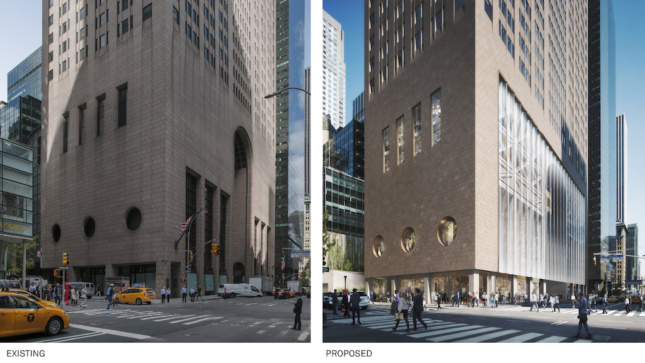The winding saga of Philip Johnson and John Burgee’s hulking 550 Madison took another turn yesterday, as New York City’s Landmarks Preservation Commission (LPC) considered landmarking the postmodern office tower’s granite exterior. Preservationists, architects, and colleagues of Johnson’s took the stand to deliver public testimony in favor of the potential landmarking, and even ownership spoke on how they would sensitively redevelop the building with input from the commission.
The furor over the former AT&T headquarters began with the initial reveal of Snøhetta’s plan to glass over and encase the base of the tower in October 2017, demolishing the great archways and loggias that, at the time of the building’s opening in 1984, formed a looping privately-owned public space (POPS). The original plan would have stripped the base’s defining 110-foot-tall granite archway and redefined the balance between what had been designed as a tripartite structure (the looming base, the center wall of windows, and the ornamental “Chippendale” topper).
The LPC moved quickly to calendar the building in November of last year but also noted that, due to development partners Chelsfield America and Olayan America’s decision to demolish the lobby (against the wishes of Community Board 5), only the exterior would be under consideration.

At the most recent meeting of the Landmarks Committee, Seth Pinsky, executive vice president of RXR Realty—now a minority partner on 550 Madison’s redevelopment—spoke on behalf of the building’s owners and discussed the new scheme they would be presenting. Snøhetta’s glass curtain wall is out, and ownership now officially supports landmarking the tower’s exterior. As a result, they would also like to remove the building’s rear annex and renovate the arcade covered by Gwathmey Siegel Kaufman during their 1993 renovation for Sony and bring the rear yard condition closer to Johnson and Burgee’s original vision. This would create a much larger enclosed garden and seating area.
As for the tower’s interiors, originally designed for single-tenant occupancy and for a maximum of 800 employees, Pinsky stated that the current plan was to build out Class A office space for up to 3,000 potential workers.
Honored to have been @nyclandmarks today to testify in favor of landmark designation for AT&T. I recalled writing about the design in @nytimes when it was just an idea, calling it “the most provocative and daring skyscraper to be proposed for New York since the Chrysler Building” https://t.co/ijyoHCfttZ
— Paul Goldberger (@paulgoldberger) June 19, 2018
The vast majority of testimony read at the hearing was in favor of landmarking the former AT&T Building. Some in attendance spoke on the building’s noble intentions but purported failure to connect with the street level; in Richard Rogers’ statement, delivered via surrogate, it was noted that while the tower itself has always been impressive, the successive series of interventions at the ground level have only strayed further from Johnson and Burgee’s original intention.
The committee received an additional 12 letters of support for landmark status, including from the National Register of Historic Places. Ultimately, the fate of 550 Madison will likely be determined at an unspecified later date wherein commissioners will take Tuesday’s testimony into account. The building’s owners will continue to tweak their proposed scheme in the meantime.
AN will continue to provide updates as they become available.











